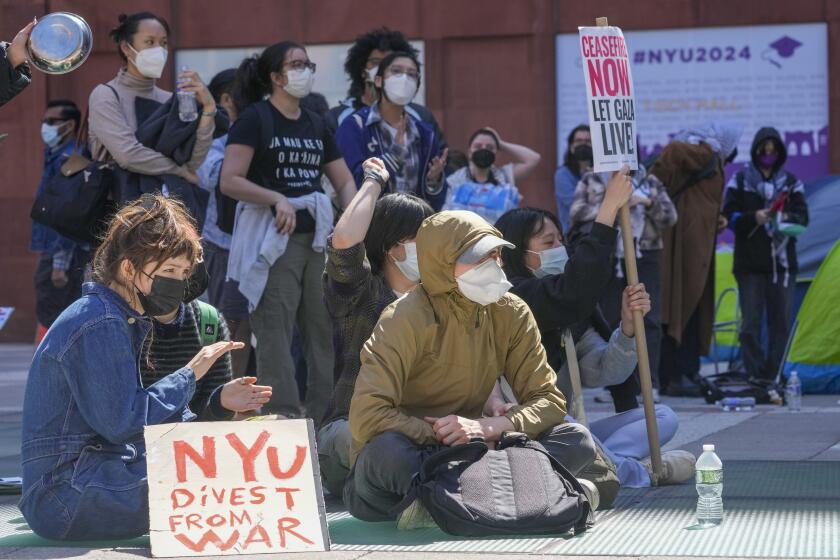Maryland Puts a Premium on Employer-Paid Healthcare
With a dramatic vote to approve a path-breaking bill late last week, the Maryland Legislature may have provided the jolt that could revive the comatose national debate over expanding access to healthcare.
The Maryland legislation, which requires large employers to contribute to healthcare for their employees, apparently would affect only a single company: Wal-Mart.
But the bill could have a powerful ripple effect because it brings back to the surface an issue that has been submerged for too long: the role of employers in maintaining access to health insurance.
And that debate could ultimately pressure business to join with other key interests to craft solutions to the debilitating spiral of rising costs and declining access.
Business hasn’t been a target in the healthcare debate since the 1994 collapse of President Clinton’s blueprint for universal coverage. Clinton proposed a “play or pay” plan that would have required all employers to insure their workers or pay into a federal fund for the uninsured.
Some large employers that provide insurance initially welcomed the proposal as a way to level the playing field with companies that saved money by refusing coverage. But small-business groups, many of whose members said they could not afford to provide insurance, fiercely opposed the idea. And after those groups played a central role in sinking Clinton’s overall package, healthcare reformers over the next decade looked to government, not business, to fund expansions of coverage.
The Children’s Health Insurance Program that passed in Clinton’s second term used state and federal tax dollars to cover children of the working poor.
In the 2000 and 2004 campaigns, Democratic presidential nominees Al Gore and John F. Kerry avoided employer mandates and instead proposed to cover more of the uninsured entirely through public dollars. Kerry, in fact, offered to subsidize employers now providing coverage through an innovative proposal for Washington to absorb part of the cost for workers who generated the biggest healthcare bills.
President Bush has proposed much more limited measures to expand coverage, but his ideas -- mostly tax credits for the uninsured -- also rely on public, not private, dollars.
While business avoided the political spotlight, the structure of employer-provided healthcare eroded. With fewer employers offering insurance and more workers refusing it when offered because of high costs, the percentage of Americans receiving coverage at work has dropped every year since 2000, the Census Bureau reports. Today, 60% of Americans receive healthcare through their employer, down from 64% in 2000.
“What we’ve witnessed over the first half of this decade is the melting of the polar ice cap of employer-provided coverage,” says John McDonough, executive director of the Massachusetts advocacy group Health Care for All.
That ominous trend attracted little attention in Washington. But in the states, it prompted a trickle of activism now widening into a flood.
Among the first states to act was California -- former Gov. Gray Davis, just before his 2003 recall, signed legislation requiring all firms with 50 or more employees to insure their workers. In 2004, the state business community sponsored a ballot measure that repealed the law, but the unexpectedly close result (49.2% of voters backed the mandate) signaled that the issue’s politics might be shifting.
Thursday’s action in Maryland sent the same message. Overriding a veto by Republican Gov. Robert L. Ehrlich Jr., the Democratic-controlled state House and Senate voted to require all private employers in Maryland with 10,000 or more workers to spend at least 8% of their payroll on healthcare or contribute to the state’s Medicaid program. Four Maryland companies employ that many workers; only Wal-Mart is believed to fall short of the 8% threshold.
Bills imposing similar mandates on large employers, promoted by a coalition of unions, are scheduled to be introduced in as many as 30 states this year. Jonathan Parker, national director of Americans for Health Care, an affiliate of the Service Employees International Union, says the legislation has good prospects in states as diverse as Colorado, New Hampshire and Washington.
An initiative in Massachusetts aims higher. The state’s House of Representatives last fall passed “play or pay” legislation requiring all firms with more than 10 employees to insure their workers or pay into a state fund for the uninsured. If the plan doesn’t become law -- the state Senate is resisting it in a conference committee -- McDonough says his group may put it on the ballot in November as an initiative.
This focus on employers draws resistance from some on the left and many on the right. Some liberals consider employer mandates a band-aid; they’d prefer to let the employer-based system collapse to build momentum for a single-payer national healthcare plan.
But that’s not coming anytime soon. And the unraveling of the employer-based system is the main reason that the number of uninsured Americans, which last year neared 46 million, is soaring.
Conservatives say employer mandates will kill jobs. But the existing system already kills jobs. Firms that provide insurance pay higher premiums to offset the cost of uncompensated care for all those uninsured patients. That leaves those companies with less money to hire new workers.
Employer mandates don’t make sense without subsidies for small businesses; requirements for healthy, younger employees to accept coverage when offered (which would spread risk); and a Kerry-like plan to free businesses from the most expensive cases.
But by asking employers to reach into their pockets, these state initiatives may encourage business to come back to the table -- and help craft a comprehensive solution that would equitably divide the burden of providing reliable healthcare to all Americans.
*
Ronald Brownstein’s column appears every Sunday. See current and past Brownstein columns on The Times’ website at latimes.com/brownstein.
More to Read
Start your day right
Sign up for Essential California for news, features and recommendations from the L.A. Times and beyond in your inbox six days a week.
You may occasionally receive promotional content from the Los Angeles Times.






